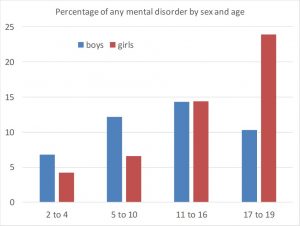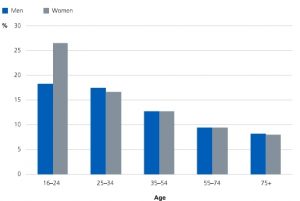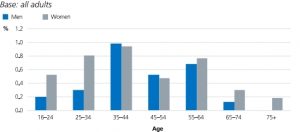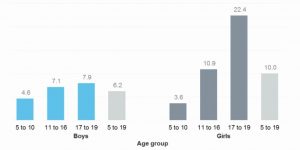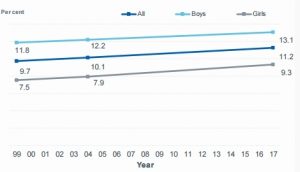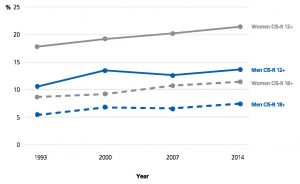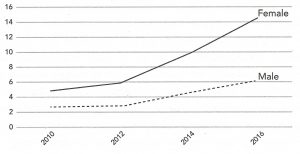 Nurse Ratched (from One Flew Over The Cuckoo’s Nest)
Nurse Ratched (from One Flew Over The Cuckoo’s Nest)
There are a couple of signs of impending totalism. The first is when the machinery of justice is subverted to serve the ends of the controlling ideology. This is partly in place already, and continues to gain a greater hold, see here and here and here and here and here. The second sign is when dissent is recharacterized as mental illness. No sane person could possibly disagree with the glorious ideology which our beneficent leaders would impose upon us: therefore you are mad.
If you have just returned from interplanetary space travel you may not have heard about the American Psychological Association’s recently published Guidelines for the Psychological Practice with Boys and Men. The APA published their Guidelines for the Psychological Practice with Girls and Women over eleven years ago, in 2007. The two documents – for men and for women – read rather differently, though both are expositions of feminist dogma: the latter relating to the victimised, and the former to the oppressor. Yes, they really are that unsubtle.
The guidelines for boys and men have met with widespread criticism. The criticism did not escape the APA’s notice and they felt it necessary to issue a statement ‘Addressing Media Misrepresentation of the Men’s Guidelines’. The Statement merely reiterates their position. But the criticisms were not just from the media but also from some psychologists, for example from John Barry, one of the leading lights in the new Male Psychology Section of the British Psychological Society.
The British Psychological Society (BPS) has not published formal guidelines on psychiatric treatment for boys and men, but it has published a large and radical document called the ‘Power Threat Meaning Framework’, with lead authors Dr Lucy Johnstone and Professor Mary Boyle. This initiative seeks to overturn the whole basis of psychiatric diagnosis. The proposed radical alternative to conventional mental disorder diagnosis starts with questions such as, ‘how is power operating in your life?’ and ‘what kind of threats does this pose?’. Therapy starts by asking, ‘what did you have to do to survive?’ and ‘what access to Power resources do you have?’ I do not intend to be drawn into a digression on the philosophical origins of this slant on mental disorders (and, indeed, on everything) other than to note that, as these examples demonstrate, it puts victimhood and power at the centre of the proposed new conception of mental disorder.
The relevance of the ‘Power Threat Meaning Framework’ is that it includes a section on men. In this respect it is broadly similar to the APA guidelines for boys and men, being firmly based on feminist dogma. (The entire document is aggressively postmodernist). The ‘Power Threat Meaning Framework’ has also attracted criticism, again including some psychologists, for example Martin Seager.
The different approaches to the two sexes proposed by these professional institutions could not be more stark. Stripped down to its essentials, both claim that mental disorders suffered by men and boys are, in large part, due to “traditional masculinity”, or patriarchy. Moreover, the mental disorders suffered by women and girls are also perceived as commonly the product of patriarchal society, i.e., “traditional masculinity”. The ‘Power Threat Meaning Framework’ expresses how women’s oppression under patriarchy is reinterpreted as mental disorder, noting the existing criticisms of…
‘the psychiatric diagnostic system for systematically pathologising what are seen as women’s rightful and reasonable responses to unreasonable events occurring in repressive, dangerous and damaging social contexts…..feminist psychologists have challenged abnormality as a construct and gender bias within psychiatric diagnosis, arguing that it is the “pathologies” of patriarchy, of racism, classism, heterosexism and ableism that are the “disorders” women suffer from, not “disorders of mental illness’”.’
It is startlingly bold to suggest that women do not, in fact, have mental illnesses, but that their appearance of mental illness is actually an artefact of their oppression – but this hypothesis appears to be seriously entertained. It’s hard not to use the word “bonkers”, so I do.
The APA’s guidelines on women and girls also allude to men as culpable for women’s mental disorders,
‘The abuse and violence in U.S. society (e.g., abuse, battering, rape) may contribute to the development of dysfunctional behaviors, such as eating disorders, depression, anxiety, and suicidal behavior, whereas discrimination against women and girls of color can result in lowered self-expectations, anxiety, depression, and negative attitudes toward self.’
Ah, “may”! I may redecorate the house, but I doubt it. No evidence is offered to support “abuse and violence” being responsible for women’s elevated rates of “dysfunctional behaviours, eating disorders, depression, anxiety, or suicidal behaviour”.
The APA’s guidelines for girls and women reiterates some familiar, and egregious, examples of the empathy gap, for example,
‘Good practice requires that psychologists remain abreast of new developments in contemporary social forces and their interaction with gender and other social identities. Many contemporary issues could be cited here; however, four particularly salient and recent examples include (a) the increasing prevalence of global terrorism, violence, and war in which women are particularly victimized by vulnerability to rape, assault, and poverty; (b) the effects of the media in popular culture, which portrays an image of woman as thin, White, sexualized, and victimized; (c) biopsychosocial realities and changes relevant to women’s reproductive experiences; and (d) the phenomenon of increasing lifespan with an aging population that consists mostly of women.’
Three of those four “social forces” impact men and boys more than women (I’ll resist the temptation to expand), and yet there is no mention of them in the APA’s guidelines for boys and men. Funny that.
The APA are clear in attributing blame for much of men’s and boy’s mental disorders on “traditional masculinity”, e.g.,
‘…socialization for conforming to traditional masculinity ideology has been shown to limit males’ psychological development, constrain their behavior, result in gender role strain and gender role conflict and negatively influence mental health and physical health.’
What the APA mean by “traditional masculinity” is as follows,
‘Masculinity ideology is a set of descriptive, prescriptive, and proscriptive of cognitions about boys and men (sic)……including: anti-femininity, achievement, eschewal of the appearance of weakness, and adventure, risk, and violence. These have been collectively referred to as traditional masculinity ideology.’
‘traditional masculinity ideology can be viewed as the dominant (referred to as “hegemonic”) form of masculinity that strongly influences what members of a culture take to be normative.’
One assumes that “anti-femininity” refers to homophobia, or to a reluctance to engage in touching or affectionate behaviour with other men.
Apparently our desire to “achieve” is a source of mental illness. Really? Do they not appreciate the importance of a sense of purpose? Our cat knows more about human psychology than these people.
These extracts are important because they make clear that what is being called “traditional masculinity” is assumed by APA to be the norm for men. Hence, in asserting that “traditional masculinity” is harmful, this carries the implication that essentially all men are culpable.
The APA does not think at all highly of “traditional masculinity”. Under Guideline 3 (‘the impact of power, privilege, and sexism on the development of boys and men and on their relationships with others’) we read,
‘Researchers in the psychology of men and masculinity have identified that insecurities stemming from early childhood experiences (such as attachment insecurities) are linked to adherence to traditional masculinity ideology. Research also suggests that insecurely attached men not only rigidly adhere to sexist gender role ideology, that they may act on those schemas in ways that promote or justify intimate partner violence.’ (sic)
‘Traditional masculinity ideologies have also been linked to parenting concerns, including work-family conflicts.’
Under Guideline 4 we read,
‘‘Additionally, traditional masculinity ideology encourages men to adopt an approach to sexuality that emphasizes promiscuity and other aspects of risky sexual behavior….. Indeed, heterosexual men’s adherence to traditional, sexist aspects of masculinity has been connected to sexual assault perpetration.’
Of the many harmful features which (we are told) are inherent within “traditional masculinity”, emotional control – or stoicism – comes in for particular criticism, as does the (alleged) reluctance to express affection, or even to touch, other men, as follows,
‘…traditional masculinity ideology discourages men from being intimate with others…… Because of the pressure to conform to traditional masculinity ideology, some men shy away from directly expressing their vulnerable feelings and prefer building connection through physical activities, talking about external matters….. and seeking and offering practical advice with their male friends.’
‘…men experience conflict related to four domains of the male gender role…..(including) restrictive emotionality (discomfort expressing and experiencing vulnerable emotions); restrictive affectionate behavior between men (discomfort expressing care and affectionate touching of other men)’
‘Psychologists can discuss with boys and men the messages they have received about withholding affection from other males to help them understand how components of traditional masculinity such as emotional stoicism, homophobia, not showing vulnerability, self-reliance, and competitiveness might deter them from forming close relationships with male peers.’
There is something disingenuous about the ostensible favour bestowed upon inter-male bonding in the above extracts, given that the same feminist dogma has led directly to the refusal to permit men’s groups on countless university campuses in the USA, Canada and the UK in recent years.
Harvard psychologist and famous author, Steven Pinker, has referred to the APA’s guidelines for boys and men as being ‘blinkered by dogmas’. One such dogma, Pinker argued,
‘is that repressing emotions is bad and expressing them is good – a folk theory with roots in romanticism, Freudian psychoanalysis, and Hollywood, but which is contradicted by a large literature showing that people with greater self-control, particularly those who repress anger rather than “venting,” lead healthier lives: they get better grades, have fewer eating disorders, drink less, have fewer psychosomatic aches and pains, are less depressed, anxious, phobic, and paranoid, have higher self-esteem, are more conscientious, have better relationships with their families, have more stable friendships, are less likely to have sex they regretted, and are less likely to imagine themselves cheating in a monogamous relationship.’
The claims in the APA guidelines of homophobia, and men’s inhibitions against affectionate friendships with other men, seem painfully out of date. Homosexuality is now normalised, and ‘softer’, more physically affectionate, behaviours amongst men no longer excite any comment or concern.
The difference between the APA guidelines for males and for females could hardly be more startling. Mental ill health in females is due to their mistreatment by society, especially its male component, whilst men are to blame for their own ills. Nor can this be evaded by appeal to it being applicable to only a few pathological men. The text makes clear that “traditional masculinity”, complete with its array of claimed pathologies, is the dominant form of masculinity which society takes to be normative. The different treatment of men and women recommended by the APA has formed the basis of a Title IX complaint against Harvard University, who partner with the APA and whose program in clinical psychology is accredited by the APA.
Bringing all the above extracts together, we see that the APA are claiming that “traditional masculinity” causes men to be prone to partner violence, family problems, sexual assault perpetration, and being emotionally stunted, homophobic loners – not forgetting being the cause of women’s mental ill health as well.
Did the authors ask themselves what effect these views were likely to have on prospective male patients? I can only speak for myself: should I ever suffer from a mental disorder, I am now firmly deterred from seeking help from these professionals. This is ironic in view of the APA writing,
‘Research suggests that socialization practices that teach boys from an early age to be self-reliant, strong, and to minimize and manage their problems on their own yield adult men who are less willing to seek mental health treatment.’
Yet the APA themselves note that,
‘…many men report experiencing gender bias in therapy…’
‘…investigations have identified systemic gender bias toward adult men in psychotherapy…’
‘A disparity exists between the occurrence and severity of men’s mental health problems and the disproportionately low number of men served by psychological services. It has been suggested that many men do not seek psychological help because services are not in alignment with masculine cultural norms that equate asking for assistance for psychological and emotional concerns with shame and weakness.’
Remarkably, the APA do not interpret these observations as a salutary lesson for their own practice. Instead of aiming to provide a therapeutic service aligned to the needs of the patient, the APA consider it more appropriate to demand that the patient change to align with their diagnostic preconceptions.
It’s a pity the APA takes such a pejorative attitude, and a pernicious aspect of this stems from the refusal to contemplate an innate component to male psychology. As a result, they replace a man’s shame at failing to achieve a perceived gender role with a profounder shame of his own nature. This is where the dearth of empathy takes you.
So, finally, to some data. Rather than critique the hypotheses presented by APA and the ‘Power Threat Meaning Framework’ we can take a different approach: essentially the scientific method. We can confront the implications of these perspectives with the broad aspects of the data on mental disorders, in particular their gender dependence. What follows is not rigorous, it is heuristic: a “reasonableness check”. I fully realise that different disorders have widely differing prevalence between the sexes.
Observation 1
If social constructionism were correct, as APA assume, there would be no difference between the prevalence of mental ill-health in very young boys and girls. In fact, there is a difference. I have taken data on the prevalence of mental disorders in children and young adults from official statistics published by NHS Digital and the UK Government Statistical Service (Mental Health of Children and Young People in England, 2017). The survey from which these data were collected involved 9,117 children aged 2 to 19 in England between January and October 2017. The summary report is augmented by a sequence of topic reports here. Boys exhibit a significantly greater prevalence of mental disorders at pre-school age (2-4) and up to age 10 (see Figure 1 below). This suggests an innate difference in the sexes. (I could add that the far greater prevalence of behavioural disorders, hyperactivity and autism spectrum disorders in boys also points to innate sex differences).
Observation 2
If masculinity were entirely socially constructed and also largely to blame for men’s and boys’ mental ill-health, as APA propose, then the ratio of men’s to women’s prevalence of such mental ill-health should increase with age because the masculine cultural conditioning will not have occurred in very young children but will become far more marked towards puberty and throughout adolescence. In fact we see the opposite (Figure 1). Whilst boys show greater prevalence of mental disorders before the age of 10, in the age range 11 to 16 there is equality of prevalence, but after age 16 it is women who have the greater prevalence (Figures 1 and 2 below), and this is especially marked in ages 17 to 24. The latter is further illustrated by Figures 3 to 6, though it should be noted that there are disorders where males predominate, notably autism spectrum, hyperactivity and behavioural disorders, though the latter two are largely childhood disorders.
Data for disorder prevalence in adults has been taken from the Mental Health and Wellbeing in England: Adult Psychiatric Morbidity Survey 2014 based on a survey carried out for NHS Digital by NatCen Social Research and the Department of Health Sciences, University of Leicester, by 49 authors.
Observation 3
If traditional masculinity were a major cause of mental disorders in boys and men, as APA suggest, then over recent decades the prevalence of disorders in men and boys would be expected to have declined because boys and young men have become less ‘macho’ acculturated and more accepting of a softer, more emotive, nature, including markedly reduced homophobia. But actually the prevalence of disorders in men and boys has increased (Figures 7 and 8 for England, Figures 9 and 10 for the USA).
Observation 4
Over the last several decades, young women have become markedly more assertive, confident and often dominant in many social, educational and workplace settings. Violence in society generally has reduced, and domestic abuse in particular has reduced. If abuse were a central cause of mental disorders in girls and young women, as APA have proposed, then their prevalence would be expected to have reduced. In fact, the incidence of mental disorders in young women has increased markedly, substantially more so than for young men (Figures 7 and 8 for England, Figures 9 and 10 for the USA).
Conclusion: The feminist theories of the APA and BPS’s ‘Power Threat Meaning Framework’ fail these very elementary reasonableness checks.
Here is an alternative hypothesis, offered by Barbara Kay,
‘All this depression and anxiety “may” come from female ideologues, who as educators and role models: routinely tell girls they can “be anything” and “have it all,” which causes anxiety when “all” fails to emerge, as it almost invariably does; who encourage girls to explore their sexuality without letting emotion get in the way of healthy pleasure, but fail to warn them that promiscuity can leave them feeling sad and empty and humiliated; who valorize abortion, but fail to warn of abortion’s frequent psychological impact; who deplore early commitment, even when a young woman and man happen to be right for each other; who encourage misandry by belittling or ignoring men’s legitimate concerns, or fail to acknowledge men’s legitimate contributions to society; who value career ambitions over motherhood; who confuse girls regarding the difference between being wooing and sexual misconduct; and of course who persuade girls and women that if they are unhappy, the reason never lies within, or from poorly-considered choices, but is always the fault of a “traditional” male asserting his privilege, or “social construction” that thwarts their self-realization.’
This perspective of Barbara Kay’s does a better job than the feminist nonsense of explaining the greater prevalence of mental disorders amongst women than amongst men.
I might add that if you are brought up to believe that the other half of the human race is dedicated to finding ways to abuse and assault you, it probably would not do your peace of mind much good. You might just suffer from an anxiety disorder. On the other hand, if you are brought up to believe that you are the heir to an unbroken line of violent abusers, and that you are under universal suspicion of being one too, then you are also unlikely to be psychologically in good shape. This view is consistent with an increasing prevalence of disorders in both sexes.
Whether there is any truth in these alternative rationalisations of the prevalence by gender of mental disorders I don’t know. But they illustrate how easy it is to do far better than the APA and the ‘Power Threat Meaning Framework’ whose ideas fail even these most elementary reasonableness checks.
Figure 1: Prevalence of Any Mental Disorder by Sex and Age from Pre-School to Young Adult (ages 2 to 19), 2017 – click to enlarge
Figure 2: Common Mental Disorders by Age and Sex in Adults (16 – 64), 2014 (for severity level CIS-R = 12+, i.e., warranting clinical recognition) – click to enlarge
Figure 3: Screening Positive for any Personality Disorder by Age and Sex, 2014 – click to enlarge
Figure 4: Prevalence of Psychotic Disorders by Age and Sex (2007 and 2014 data combined) – click to enlarge
Figure 5: Screened Positive for PTSD by Age and Sex, 2014 – click to enlarge
Figure 6: Rates of Emotional Disorders by Sex and Age (5 to 19), 2017 – click to enlarge
Figure 7: Trend in Rates of Any Mental Disorder in Childhood (5 to 15), 1999 to 2017 – click to enlarge
Figure 8: Trend in Prevalence of Common Mental Disorders in Adults (16 – 64), 1993 to 2014. Severity uses the revised Clinical Interview Schedule (CIS-R). A score of 12 indicates “symptoms warranting clinical recognition”, whereas a score of 18 or more is considered severe and requiring intervention. Click to enlarge.
Figure 9: Percentage of Adolescents, aged 12-17, who have had a Depressive Episode in the Last Year (from “The Coddling of the American Mind” by Lukianoff and Haidt) – click to enlarge
Figure 10: Percentage of College Students Reporting a Current Psychological Disorder (from “The Coddling of the American Mind” by Lukianoff and Haidt) – click to enlarge
